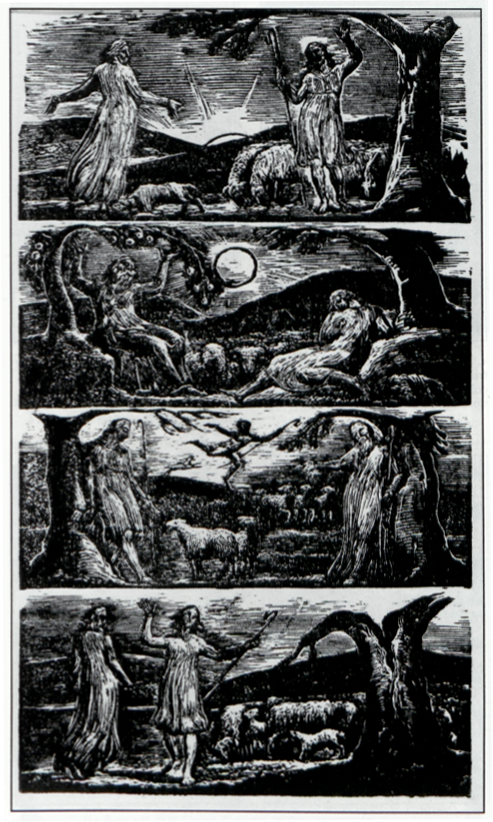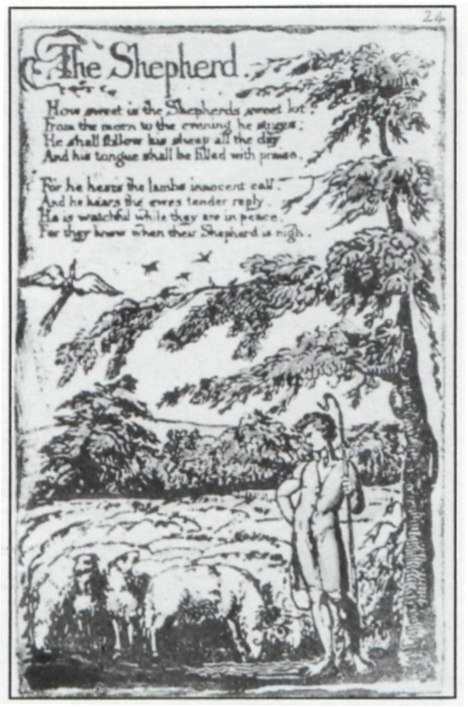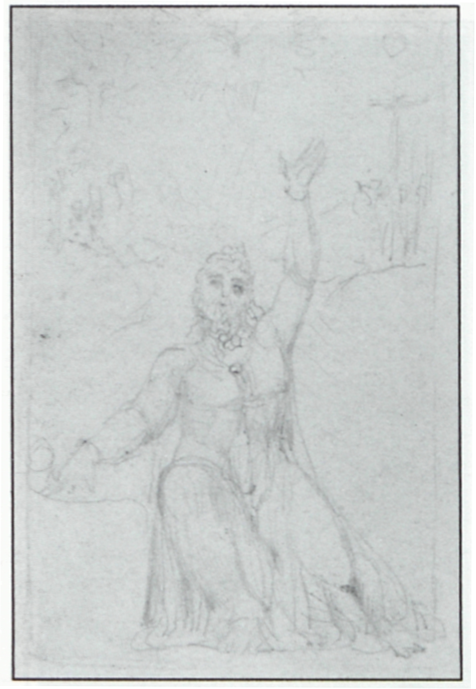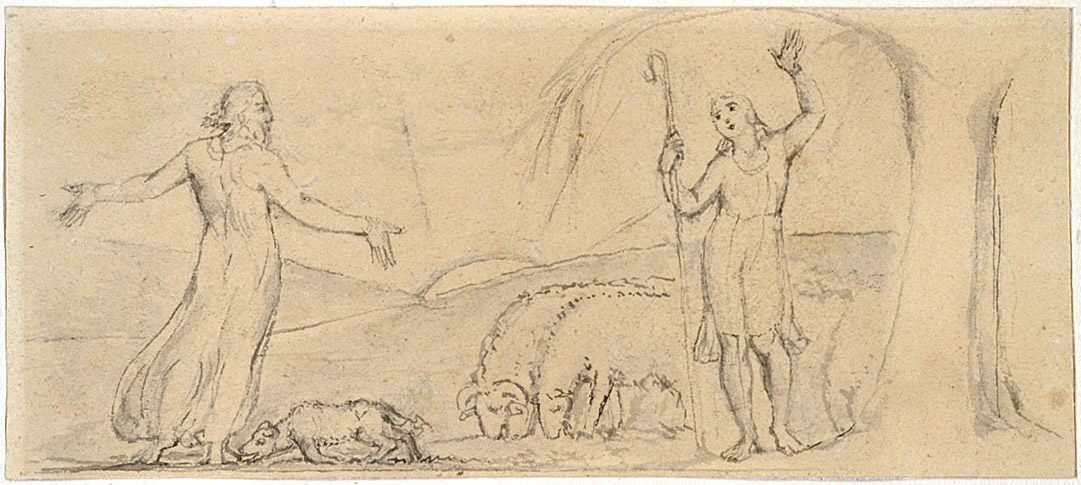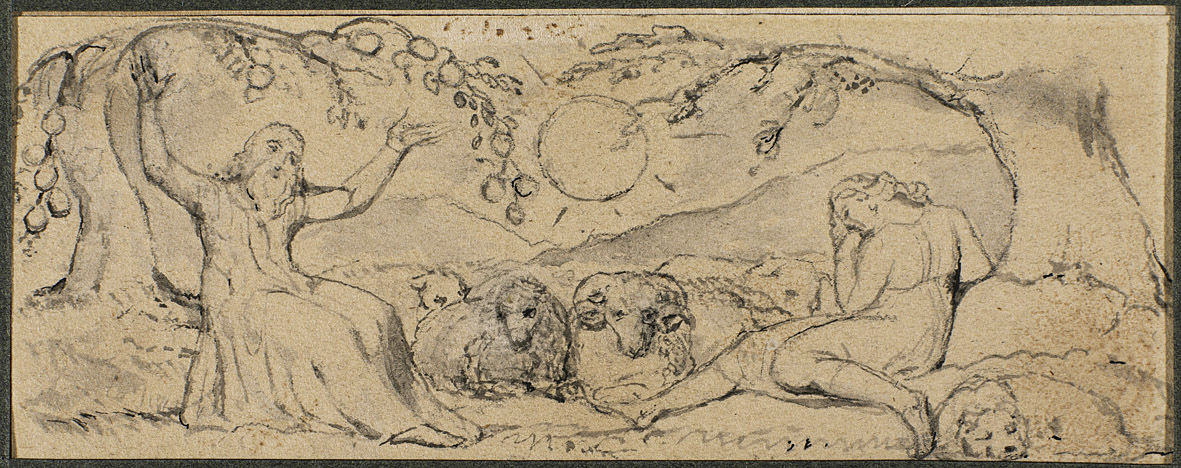article
begin page 117 | ↑ back to topA Relief Etching of Blake’s Virgil Illustrations
The discovery of what purports to be a previously unknown work by a major poet or artist provides a variety of pleasures.*↤ I am grateful to Nancy Bialler, Martin Butlin, Thomas V. Lange, and Joseph Viscomi for their assistance with this essay. Something akin to the sublime can strike the devotee on first hearing or seeing—surprise, wonder, fascination. Pronouncements based on instinctual connoisseurship soon follow. Doubters take equal relish in a dismissive sneer and a Shakespearean comment on those taken in (“What fools these mortals be”). If the now controversial object is on the market—and particularly if it enters that last refuge of unabashed capitalism, the auction room—the true believers are challenged to put their money where their poinions are. Next the scholars, if allowed access, take command. Those who think they have convincing arguments for an attribution proceed rapidly into print, ever fearful that the debunkers will respond with even more compelling arguments. A recently discovered print (illus. 1), immediately identifiable as a version of four of Blake’s illustrations to Ambrose Philips’ “Imitation of Eclogue I” in Robert John Thornton’s school Virgil of 1821, has already proceeded through much of the process outlined above. What follows is an attempt to carry the print into the penultimate stage and argue for its authenticity as a work designed, executed, printed, and hand-corrected by William Blake.
In the late summer or early fall of 1990, a member of a Venezuelan family brought to Sotheby’s New York a copy of Alexander Gilchrist’s Life of William Blake, 1863. Although still in the original publisher’s binding, the copy was extra-illustrated with the Virgil print and several of Blake’s rarest graphic works, “The Chaining of Orc,” “The Man Sweeping the Interpreter’s Parlour,” and well-printed impressions
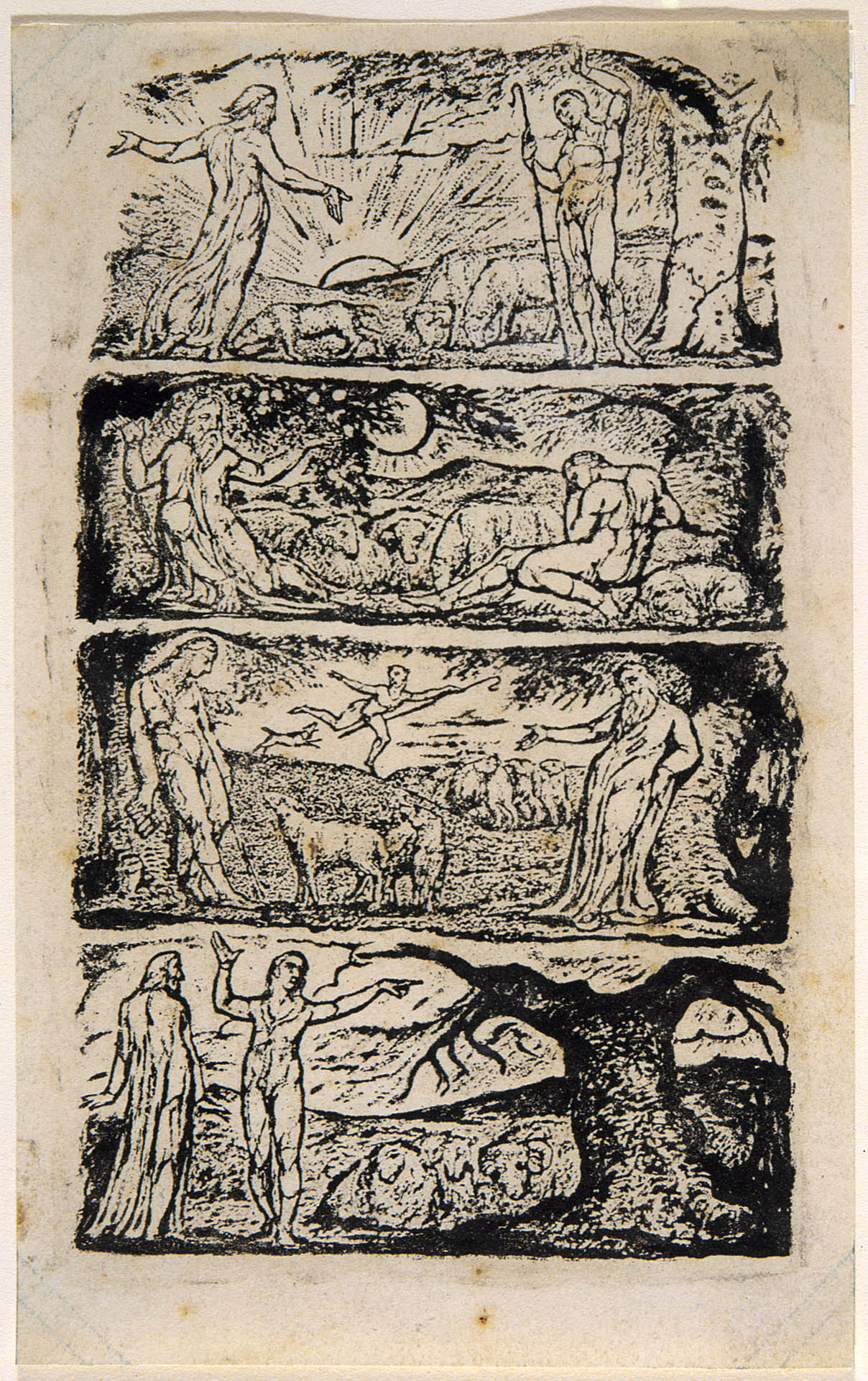
[View this object in the William Blake Archive]
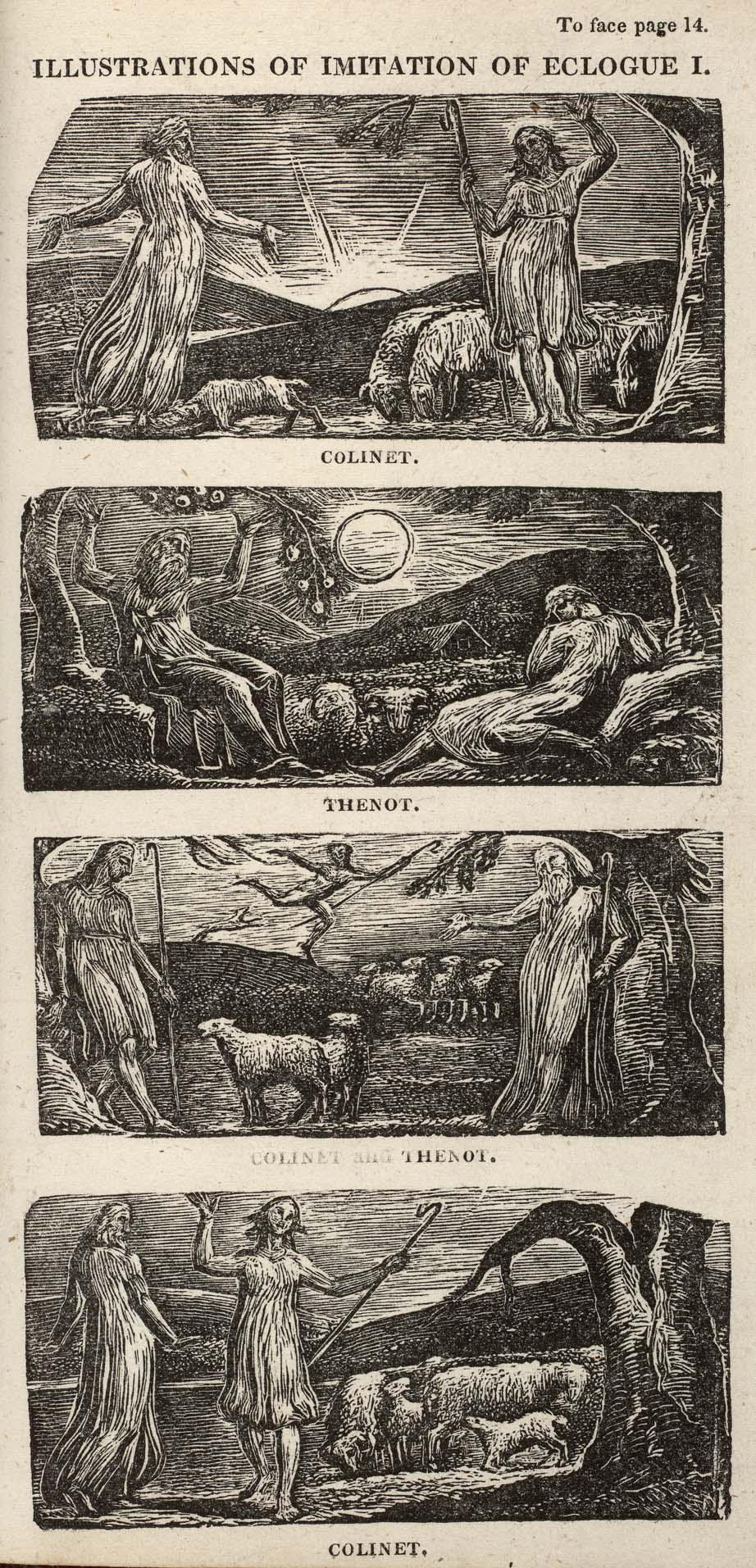
[View this object in the William Blake Archive]
Nancy Bialler of Sotheby’s Print Department, an expert in the graphic arts in her own right, immediately sought out professional opinions concerning the authenticity of the Virgil print. One British Blake expert was sent a photograph of the work and quickly pronounced it a fake. Several others, including G. E. Bentley, Jr., Donald begin page 119 | ↑ back to top Heald, Justin G. Schiller, Jenijoy La Belle, Thomas V. Lange, and myself, all tended to believe in the print’s authenticity upon first inspection of the object itself. In her essay on the extra-illustrated Gilchrist, “William Blake Discoveries,” Sotheby’s Preview (April/May 1991): 16-17, Bialler reproduced the Virgil print, noted that “expert opinion is divided” as to its attribution, that “it is difficult to fit the . . . print into the sequence of other works related to the Virgil project,” but that its “innovative technique [on which more later] strongly suggests the hand of Blake.” To sell the prints, Sotheby’s disbound all but the Gates of Paradise plates (plus an inconsequential impression of Blake’s plate after Thomas Stothard illustrating Ariosto’s Orlando Furioso, 1783) and offered them in four lots in their 9-11 May 1991 sale of “Old Master, 19th and 20th Century and Contemporary Prints.” The Virgil appeared as lot 9, accompanied by a reproduction in the catalogue. Because of the differing views about the print’s authenticity, Sotheby’s found it prudent to describe the work as “Attributed to William Blake” and noted that, “although expert opinion is divided, we believe this print should be attributed to Blake.” Fortunately, the “Attributed” label held down the bidding that sent its companions to record levels and I was able to acquire the print through the agency of Donald Heald.
By comparing the newly-discovered print to the well-known wood engravings of the same basic Virgil illustrations (illus. 2), one can quickly perceive many small, and several large, differences in design. All the new vignettes show more image on their sides, much as in proofs of the wood blocks before they were cut down for publication in Thornton’s volumes (illus. 3). Yet, the new print does not follow the proofs in every respect, for the latter show a bit more image on the left sides of all four vignettes and a bit less on the right side of the bottom vignette. Similarly, the width of each vignette in the new
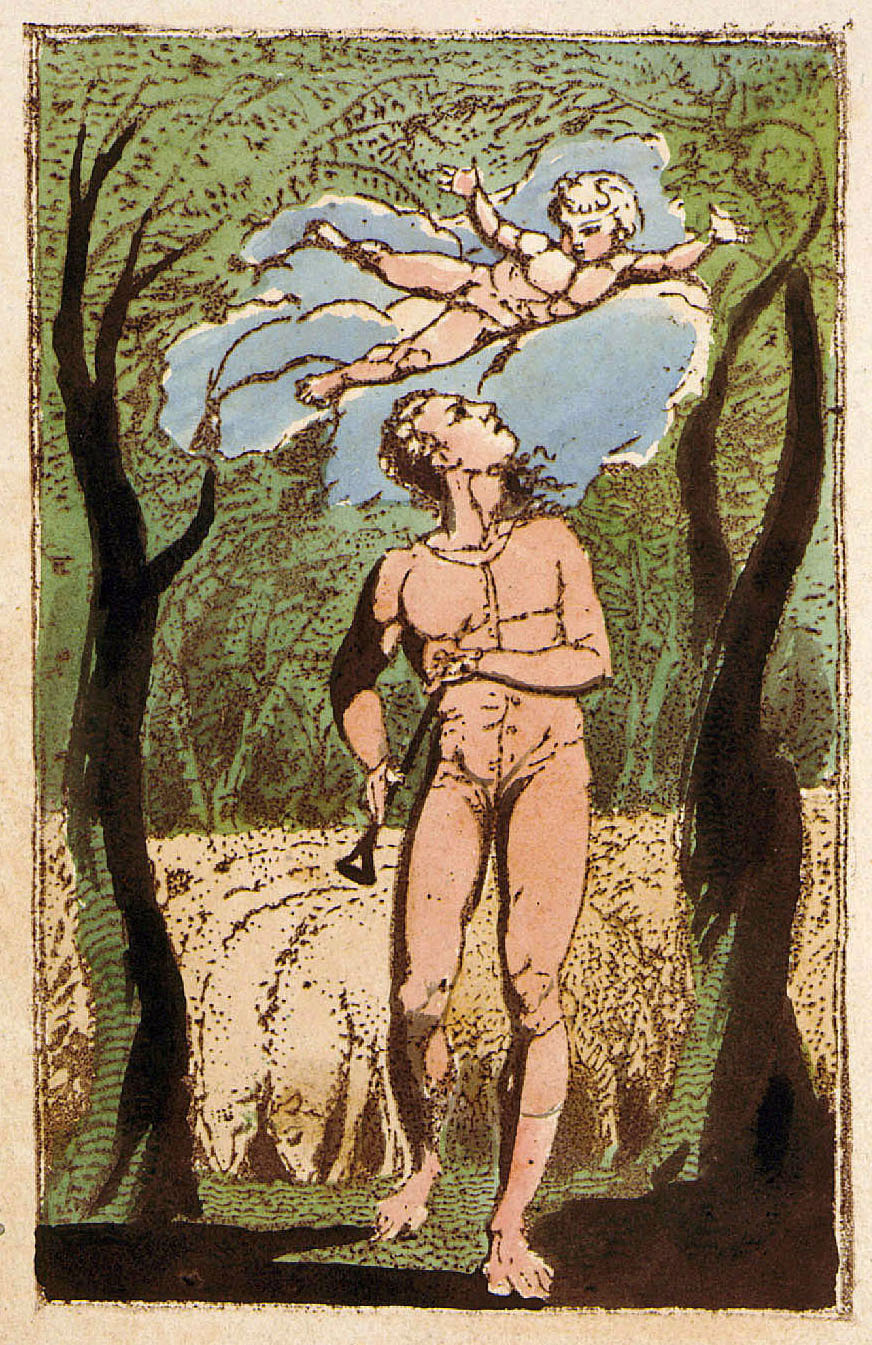
[View this object in the William Blake Archive]
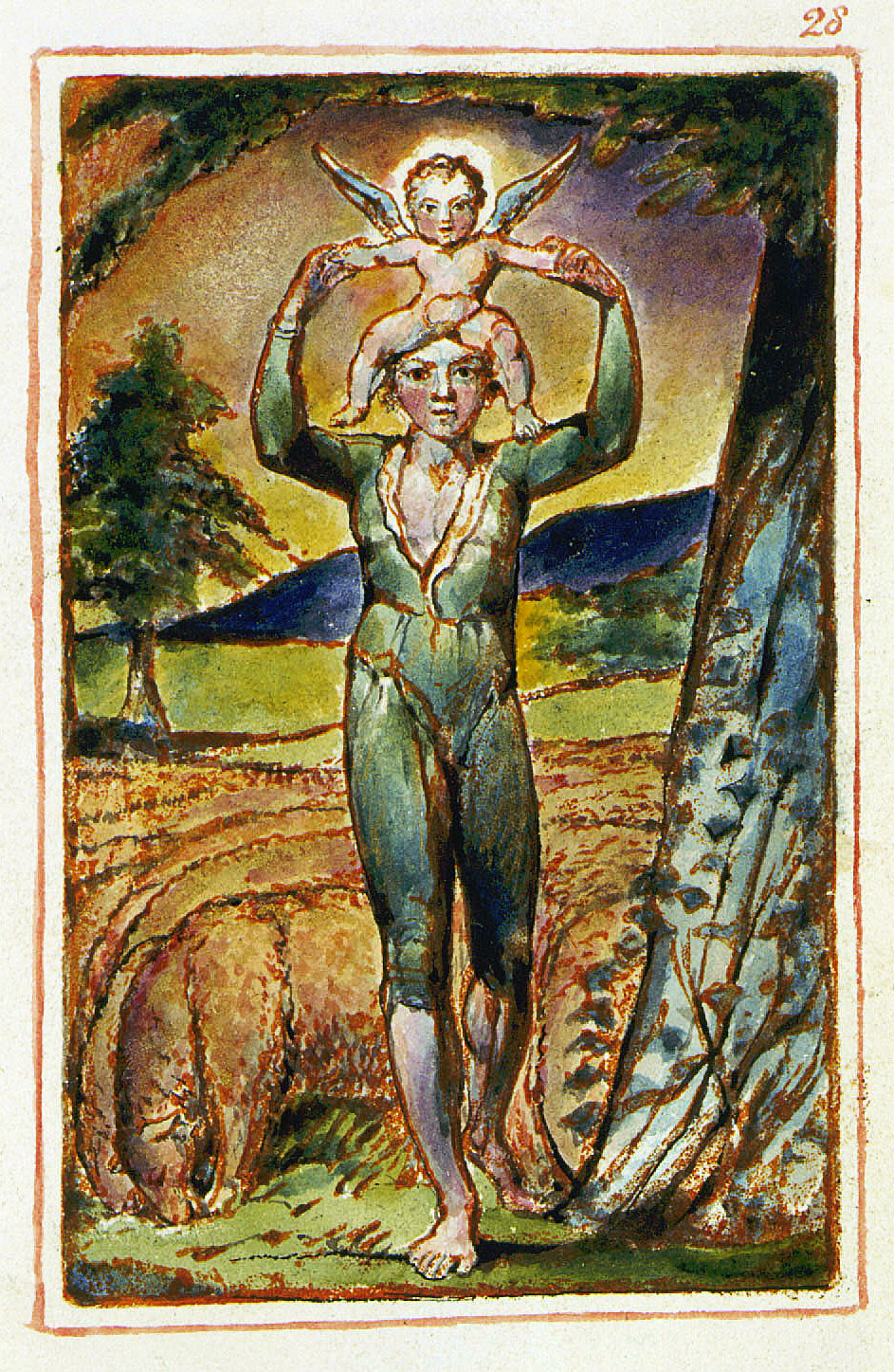
[View this object in the William Blake Archive]
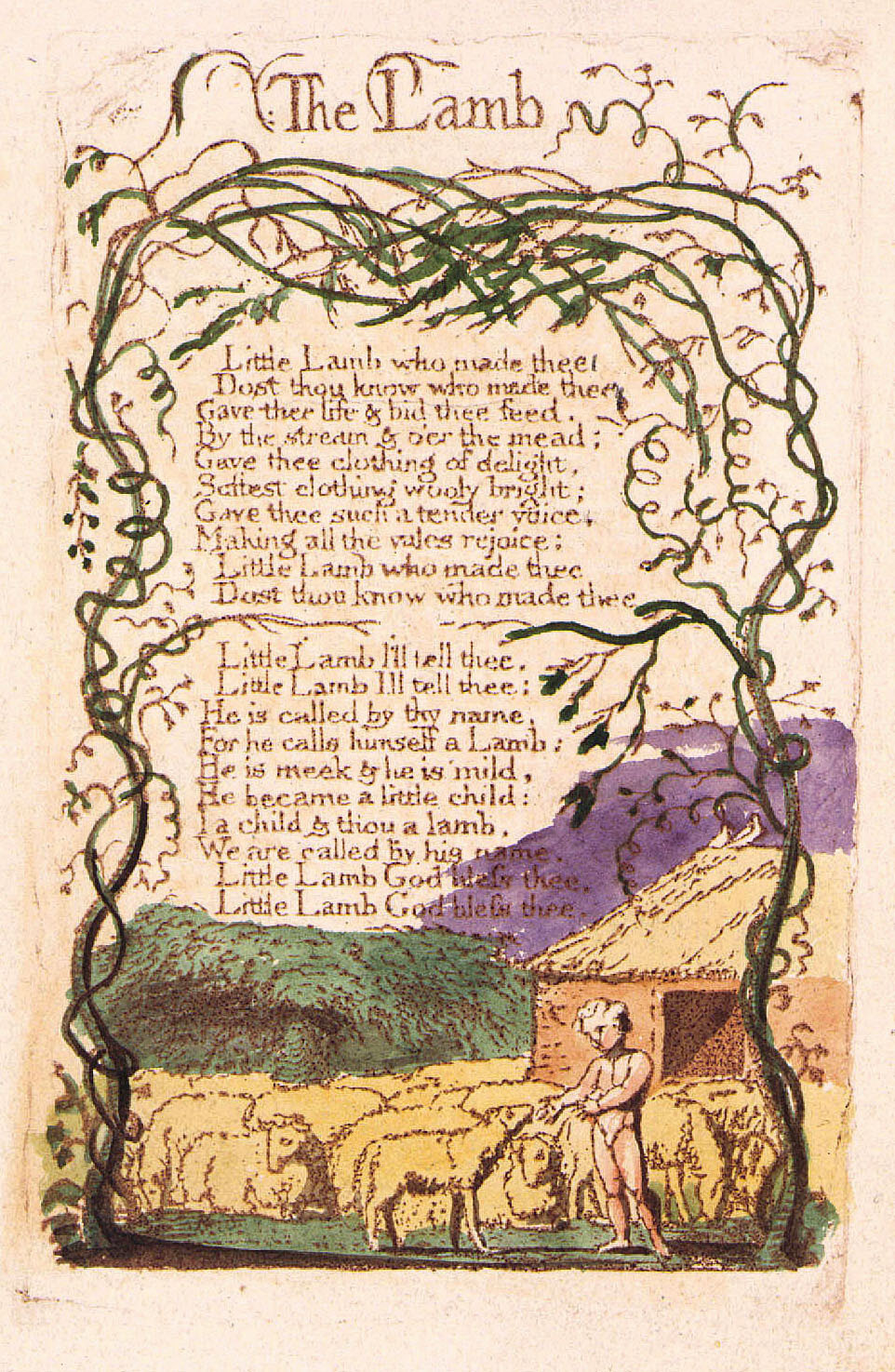
[View this object in the William Blake Archive]
Top vignette. Left arm and hand position of the figure on the left (the older shepherd, Thenot) differs from the wood engraving. The younger shepherd, Colinet, wears a transparent body stocking, not the high waisted, knee-length gown of the wood engraving. Indeed, we might think him nude except for the lines indicating mid-calf cuffs and a sleeve on his left arm. There are a great many more rays of sunlight and more foliage on the tree in the new print; a vine (ivy?) wraps itself about the lower reaches of the tree trunk (no vine in the wood engraving). A wedge-shaped cloud extends from behind Colinet’s head toward Thenot only in the new version. The left-most sheep is more clearly a ram in the new print, but the single sheep clearly pictured between Colinet and the tree in the wood engraving is not present, or at most only hinted at, in the new print. The background landscape is divided into two hills in both versions, but the right hill is forward of the left in the wood engraving and just the reverse in the new print. As in the other three vignettes, Thenot’s gown is more diaphanous than in the wood engravings and we consequently see more of his lineaments.
Second vignette from top. The new print lacks the cottage roof in the background, center right, of the wood engraving. The lines that could be easily mistaken for part of the earthen bank, lower right in the wood engraving, clearly delineate a dog, curled up and apparently sleeping, as in the preliminary drawing (illus. 13, middle). Branches of the tree on the left extend over the sun in the new print, which again shows many minor differences in vegetation and the outline of the distant hills. Colinet wears his body stocking, as in the top design, but the most dramatic difference in the entire begin page 121 | ↑ back to top group is in the posture of Thenot. In the wood engraving, we see the lower half of his body from the side; in the new print, his whole body is turned toward us with right knee raised to his waist and his unnaturally elongated left leg extended far to the right. His right hand is lower than in the wood engraving and his left arm reaches to the right rather than bending upward at the elbow. The sheep closest to Thenot has her head turned to the right (to the left in the wood engraving); the sheep seen in profile above Colinet’s right leg is not present, or only hinted at, in the wood engraving. Both tree trunks are of much larger diameter in the new print (compare to the proof of the wood engraving, illus. 3).
Second vignette from bottom. Colinet again wears his body stocking and his crook rests against his left side and shoulder (more vertical, and separated from his body, in the wood engraving). The few, easily overlooked, lines below his left hand in the wood engraving clearly delineate his Panpipe in the new print. The sheep nearest Colinet holds his head higher and is more intently looking at the man than in the wood engraving. Thenot holds no crook and the tree against which he leans is more dramatically twisted in the new print. The sheep on the hill are less organized than the group marching along in almost military order in the wood engraving.
Bottom vignette. The outlines of clouds and diagonal dotted lines around the tree, perhaps representing rain, appear only in the new print. Both may be responses to the “low’ring sky” and “storms” mentioned in the passage illustrated. Colinet’s jump-suit now sports a V neckline with a rolled collar, a fashion touch perhaps hinted at by a few lines in the previous design. He lacks the shepherd’s crook, so prominently displayed in the wood engraving, thereby freeing his left hand for a pointing gesture with index finger extended. The blasted tree to which he points lacks the fissure (“thunder-scar”
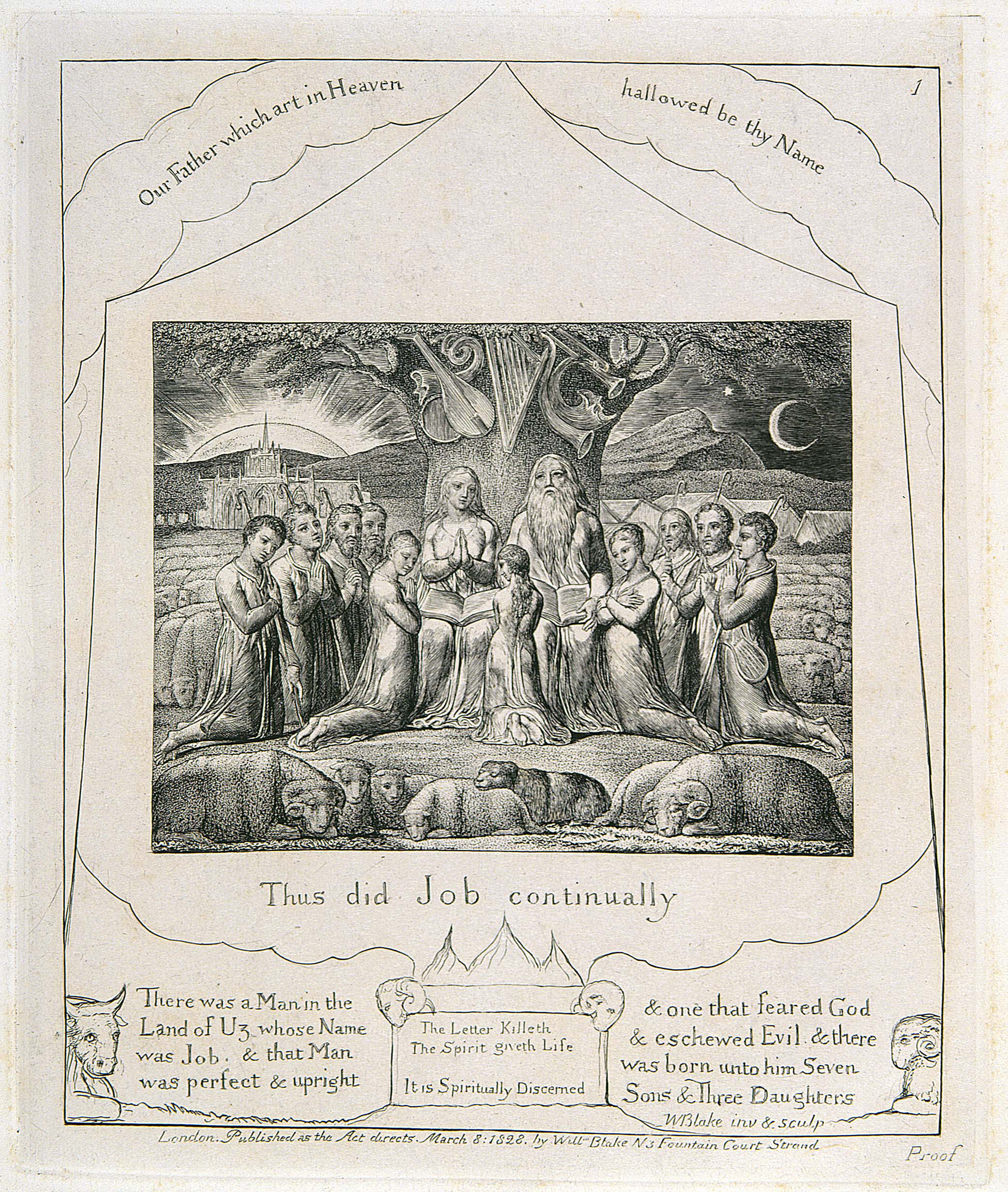
[View this object in the William Blake Archive]
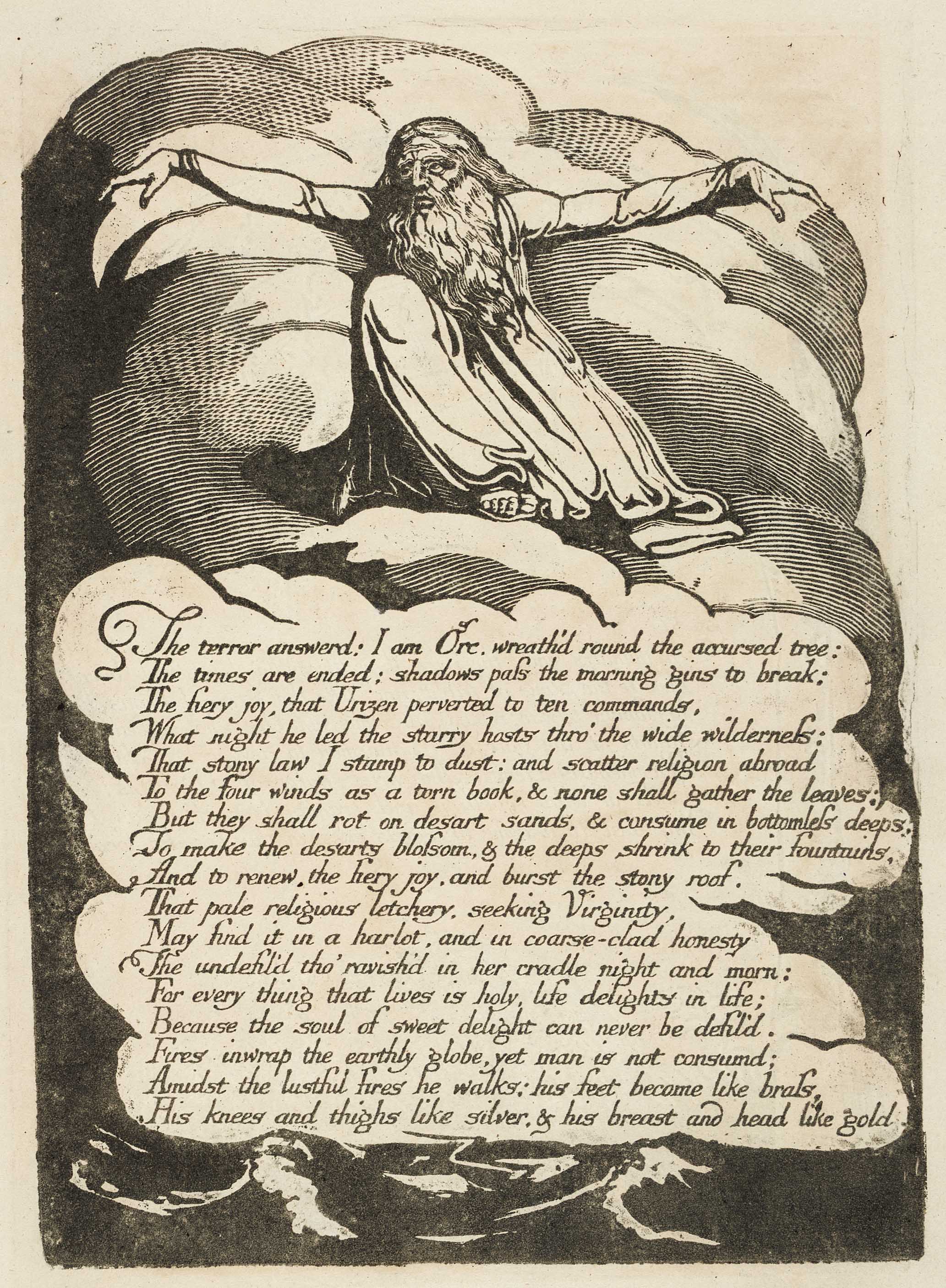
[View this object in the William Blake Archive]
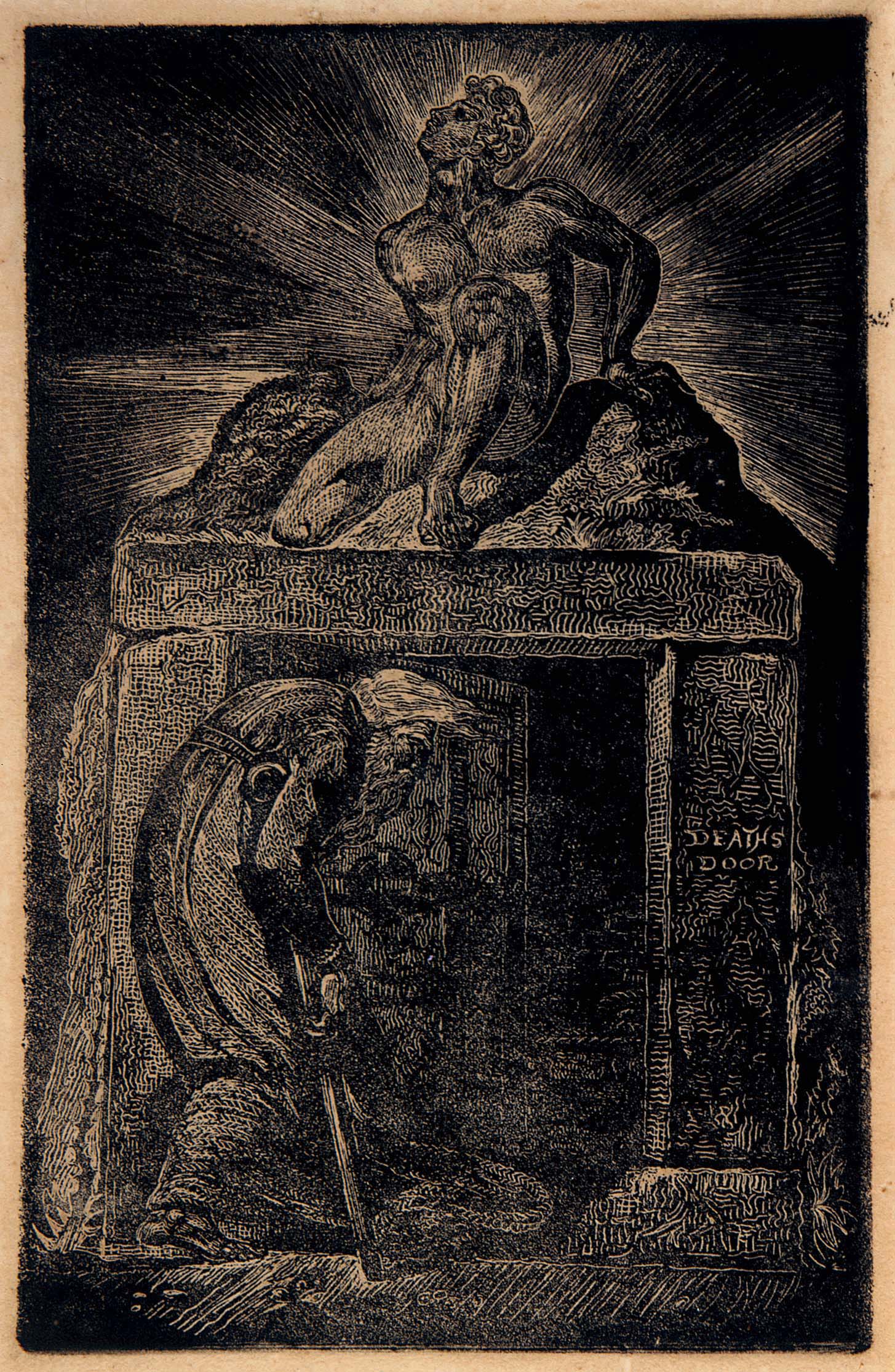
[View this object in the William Blake Archive]
The major design variants all have precedents in Blake’s work of the same and earlier periods. Colinet’s see-through body stocking was first worn by his fellow shepherd in the Songs of Innocence (illus. 4-5). In the Experience frontispiece (illus. 6), we find the V neckline and rolled collar of the bottom vignette, as well as an ivy-like vine similar to the one also climbing a tree trunk in the top vignette. Colinet’s pointing arm and finger remind one of the same gesture used by the adult male in the second plate of “The Ecchoing Green.” The sheep looking so attentively at Colinet in the second vignette from the bottom is very similar to his predecessor responding to the child in “The Lamb” of Songs of Innocence (illus. 7). The variant disposition of the sheep in the bottom vignette resembles the flocks in the first (illus. 8) and last of the Job engravings, first executed as water colors c. 1805-063↤ 3 See Martin Butlin, The Paintings and Drawings of William Blake (New Haven: Yale UP, 1981) #550.1 and 550.21 (pls. 697 and 717). Hereafter referred to as “Butlin” followed by catalogue entry number. The powerful figure of Thenot in the second Virgil vignette from the top has a long and distinguished history in Blake’s works. The basic arrangement of his legs, and in particular the prominent right knee, first appears in a small and crude form on pl. 3 of All Religions are One (c. 1788).4↤ 4 Plate numbers and copy designations for Blake’s illuminated books follow G. E. Bentley, Jr., Blake Books (Oxford: Clarendon P, 1977). In 1793, this figure became the threatening but majestic Urizen on pl. 10 of America (illus. 9). The closest parallel with Thenot is contemporary with the Virgil illustrations, The Prophet Isaiah Foretelling the Destruction of Jerusalem (Butlin 773), designed for a wood engraving never executed. In a variant preliminary pencil sketch (Butlin 772, illus. 10), Blake presents virtually the same leg posture as in the newly discovered Virgil illustration. Although the arm and hand gestures differ, both figures express a sense of patriarchal wisdom and visionary capabilities barely suggested by the much weaker figure of Thenot in the wood-engraved Virgil design (illus. 2-3). The major design variants in the new Virgil print—Thenot in the second vignette from the top, the sheep in the bottom vignette, and the clothing of Colinet in all four designs—are more typically Blakean than their very different renderings in the wood engravings.
A skeptic might argue that the variants in the new print are the sign of a pastiche manufactured by a clever forger who has produced designs that look more like some of Blake’s best known work than do the wood engravings. Yet I do not think that such an argument is persuasive. When given the commission to design illustrations for an “imitation” of Virgil’s pastorals, Blake is likely to have returned to the pictorial repertoire developed years earlier for the illustration of his own pastoral poems. Blake was probably printing copy V of Songs of Innocence for James Vine in 1820, and America copy O for John Linnell in this same period, and thus the precursor designs for the Virgil illustrations would have been recently before Blake’s attention. We see much the same sort of borrowings—for instance, the old man entering a tomb from America pl. 14—in Blake’s illustrations for Robert Blair’s The Grave (illus. 11), executed quickly for a commercial project in 1805. None of the variant motifs in the Virgil print are copied mechanically from known Blake designs; rather, they show an evolution within basic compositional paradigms of the sort produced by an original artist. The many minor variants without clear iconographic significance also evince the spontaneous proliferation of difference within the work of an artist for whom every act of execution was a chance for re-conceptualization. It would take a very clever forger indeed to capture not only Blake’s style, but also his sensibility and typical working habits, with such success.
The analysis of design variants leaves at least some lingering doubts. For me, these are stilled by a consideration of the newly-discovered print’s material and technical features. Blank sheets of early nineteenth-century paper are still to be had, particularly if one is willing to cut the flyleaves from old books, but at least we should expect the right sort of paper in any impression from Blake’s own hand. He very rarely used anything other than wove paper for his prints. As Sotheby’s auction catalogue points out, the new Virgil print is on a “‘Whatman-type’ wove paper” very similar, perhaps even identical, to several of Blake’s works of the early 1820s. Its texture—smooth and fairly hard—and thickness of 0.19 mm. match what we find in The Ghost of Abel, both copy C in the Huntington Library and the impression of pl. 1 in my collection, and the first title page to the Genesis illuminated manuscript, showing a begin page 123 | ↑ back to top Whatman 1821 watermark, also in the Huntington. In contrast, Whatman papers of 1825 (the Job engravings), 1826 (the second Genesis title page), 1831, and 1832 (posthumous copy h of Songs of Innocence and of Experience) are all slightly thicker, at 0.21 mm.
The technique used to create the new Virgil print is the most convincing single piece of evidence for its attribution to Blake. It is unmistakably a relief etching, executed with great skill.5↤ 5 “Relief etching” is the term generally used to name the graphic medium Blake used for most of his illuminated books. For descriptions of the basic process and the characteristics of the prints it produces, see Robert N. Essick, William Blake Printmaker (Princeton: Princeton UP, 1980) 85-120, and Joseph Viscomi, The Art of William Blake’s Illuminated Prints ([Manchester]: Manchester Etching Workshop, 1983). Some of the smaller relief plateaus, when viewed under low-power magnification, are indented slightly into the paper—a sure sign of relief printing. The slight platemark, a shadow line of the outer edge of the relief etching border, wiped almost clean of ink in this impression, is typical of Blake’s technique and also reveals that all four vignettes were etched on a single piece of metal—very probably copper, since a softer metal such as pewter would not be suitable for such delicate work. The necessity for this border in relief etching, created by the wall of wax containing the acid, may have forced the vignettes to present less image on their left sides than what we see in proofs of the wood engravings (illus. 3). The plate shows no evidence of white-line etching or engraving, for even the stipple-like effects on the sheep and landscape background were created through the positive, black-line process of relief etching alone. We see a similar refinement on Blake’s basic technique in the concluding vignette to The Ghost of Abel (illus. 12)—compare, for example, the stippling on the lower figure’s back with the sheep in the top vignette. This technique, combined with what are for a relief etching extremely thin lines, permitted the artist to create a work more delicate than the wood engravings and give to faces and gestures more detailed expressiveness. I know of no forgeries or facsimiles of Blake’s relief etchings that even approach the artistry of this work. One can still prefer the wood engravings for their brooding intensity, but it is hard to conceive of anyone other than the inventor of relief etching handling the process with such consummate skill. If the new Virgil print is the work of a forger, he has surpassed all but a few of Blake’s own relief etchings in technical excellence.
The characteristics of the specific impression at issue indicate that Blake was its printer. The thick and somewhat grainy ink with reticulated patches is typical of his work and distinguishes this print from Frederick Tatham’s posthumous impressions of Blake’s relief plates. Lithographs and zincographs, used to facsimile Blake’s illuminated books in the nineteenth century, are more thinly inked and have smoother surfaces. Their slight reticulations visible under magnification are much more evenly distributed and consistent than what we find in the Virgil relief etching. The wiped etching border also suggests Blake’s hand, for Tatham inked and printed the borders. But it is the subtle handwork on the new Virgil print that speaks most eloquently for an attribution to Blake. Several areas in the print have been touched with a black wash almost indistinguishable from the printed image and perhaps executed in the same pigment, suspended in diluted glue, used for the ink. All six trees bear slight touches, with a large patch just above Thenot’s raised right hand in the second vignette from the top which might even be visible in the accompanying reproduction. We can find a similar use of hand-tinting in black to improve on the relief etchings in copy BB of Songs of Innocence and of Experience (see illus. 5) and on the unique impression of the white-line etching of “Deaths Door” (illus. 11). In the latter case, the handwork may have been added to compensate for slight weaknesses in the printed image and make it more acceptable to a commercial publisher. A similar motive may lie behind the tinting on the Virgil relief etching, so typical of Blake’s own hand and not to be found in either posthumous impressions of the illuminated books or forgeries of them.
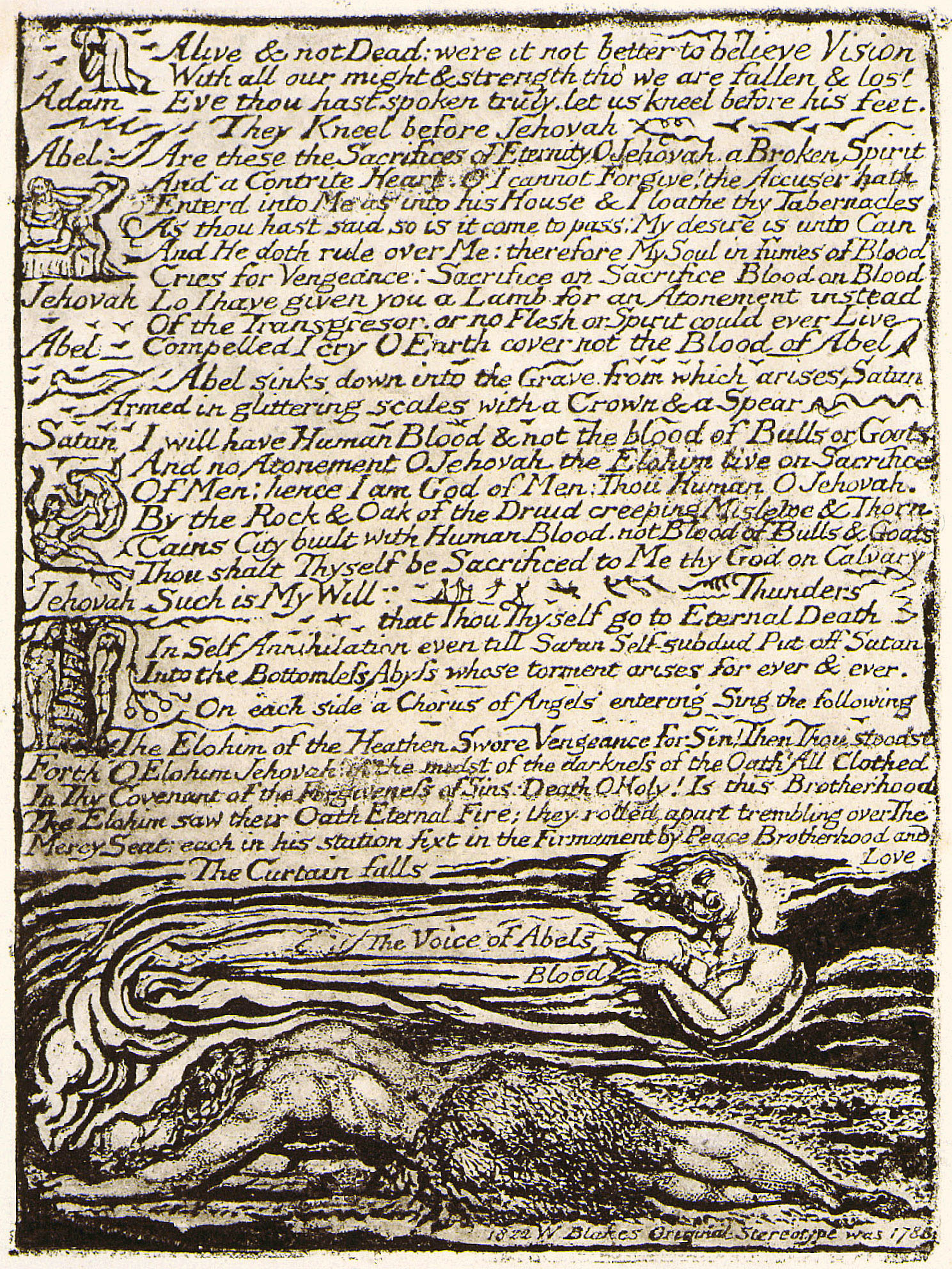
[View this object in the William Blake Archive]
A necessary step in a successful argument for attribution is to fit the new discovery into the compositional sequence of the project to which it supposedly belongs. As Bialler points out, this would seem a difficult task in the case of the Virgil relief etching. The major stumbling block is that Blake’s preliminary drawings (Butlin 769) for the series generally accord with the wood engravings, not the relief etching (see illus. 13).6↤ 6 The drawing for the fifth cut (bottom vignette in the group at issue) is untraced and unrecorded. There is no vine in the drawing for the top vignette and Colinet holds his crook away from his body in the drawing for the vignette second from the bottom. Colinet wears his knee-length gown, and Thenot his less revealing costume, in all three drawings. The older shepherd and the sheep in the drawing for the second vignette from the top are arranged as in the wood engraving (illus. 2-3). Two lines in the drawing hint at the cottage roof in the middle distance, as in the wood engraving. However, the position of Thenot’s left arm and hand in the drawing for the top vignette is midway between the relief etching and the wood engraving, while the absence of Thenot’s crook in the drawing for the second vignette from the bottom begin page 124 | ↑ back to top
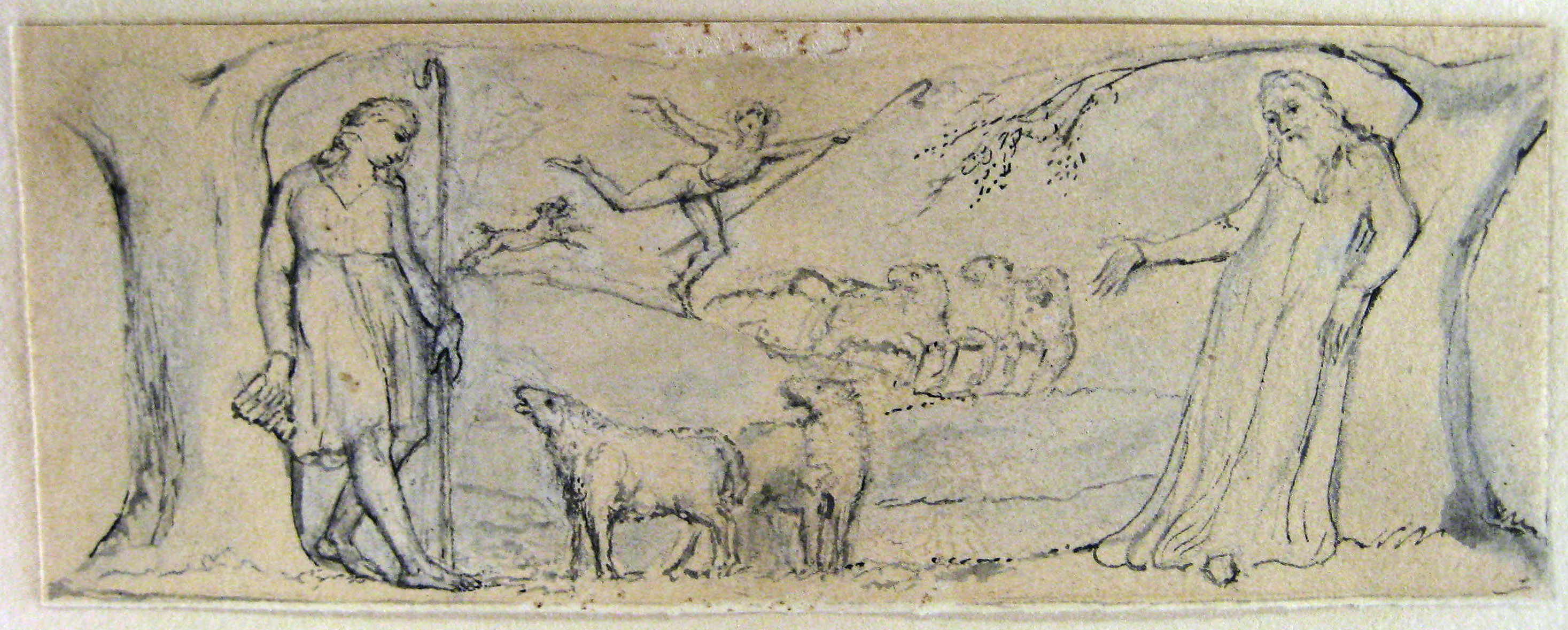
Conventional intaglio etching and engraving require the preparation of the design in a different medium, usually a drawing on paper. The image is then transferred, often by mechanical or semi-mechanical means such as counterproofing or caulking, to the metal plate. Blake’s method of relief etching allows for—indeed, promotes—initial composition directly on the metal. The drawing surface and the printing surface are one. All that is required is a loose pencil sketch like those for some of Blake’s illuminated books in his Notebook (Butlin 201) or the alternative drawing for two pages from The Book of Thel(Butlin 218, now in the British Museum). The present absence of detailed preliminary drawings or mock-ups for the illuminated books cannot prove that Blake never made any, but surely he realized that one of the great advantages of relief etching was its direct and autographic nature, one that unites the early stages of composition and the final stages of graphic execution.7↤ 7 For more on the autographic nature of relief etching, see Viscomi, The Art of William Blake’s Illuminated Prints 4-8. Thus, as odd as it may seem from the perspective of conventional graphics, the Virgil relief etching may very well be the first extant composition in the series, preceding both the carefully executed pen and wash drawings as well as the wood engravings. Blake probably did some pencil sketching on paper before turning to the relief etching, but no evidence of such first-steps has survived. This absence of rough preliminaries is also true of the vast majority of the relief-etched designs in the illuminated books.
Once one accepts the new Virgil print as authentic and places it first in the sequence of Virgil designs, other stages in the composing process and early accounts of responses to the designs can be seen in a new light. What follows is a retelling of the history of Blake’s Virgil compositions that takes into account the existence of the relief etching.
Robert John Thornton was the physician to the family of John Linnell, Blake’s great patron for his graphic works in the final nine years of his life. According to Linnell’s journal, Thornton and Blake called at his home on the same day, 19 Sept. 1818, and the two men may have met on that occasion.8↤ 8 See G. E. Bentley, Jr., Blake Records (Oxford: Clarendon P, 1969) 258. We do not know when Thornton commissioned Blake to illustrate the 1821 edition of his Virgil, but Blake must have been well along on the project by 15 Sept. 1820 since on that day Thornton sent Linnell a proof of “Blake’s Augustus” (Bentley, Blake Records 266), one of the intaglio prints of portrait busts Blake executed for the Virgil volumes. Whenever Blake was given the task of composing some new illustrations for Philips’ version of the first eclogue, he was in a position to know the required format of his designs. The 1821 Virgil is the “Third Edition,” as its title page announces. The first edition of 1812 was published without illustrations, but two years later Thornton produced a companion volume of designs, Illustrations of the School-Virgil, in Copper-Plates, and Wood-cuts (London: Rivington et al., 1814). These illustrations were repeated in the second edition of 1819. For the third edition, some of the earlier blocks were reprinted, including a group of four cuts (vol. 1, facing p. 55, in the third edition) arranged one above the other just as in Blake’s relief etching and wood engravings. The overall size of these four designs, 12.7 × 7.9 cm., is only a little smaller than Blake’s relief etching. A group of five cuts in the 1814 volume, with an overall height of 15 cm., is slightly larger than Blake’s work. Those involved in the production of the third edition probably knew well in advance its intended leaf size, for at 17.6 × 10.3 cm. the 1821 leaves are the same width as, and only half a centimeter taller than, the 1814 volume of illustrations.9↤ 9 The size given here for the 1821 leaves is based on three copies in original sheep, the binding in which the volumes appear to have been issued. I have never seen an uncut copy. Thus, Blake could easily have known the size and unusual format required of his illustrations well in advance of any composition and could have produced the relief etching straight away without prior use of a more conventional arrangement of his vignettes.
Blake may have thought that Thornton’s commission offered a good opportunity to incorporate his innovative graphics into a commercial project, much as he had tried to do in 1805 with the white-line etching of “Deaths begin page 125 | ↑ back to top Door” (illus. 11) for R. H. Cromek’s letterpress edition of Blair’s Grave. Like wood engravings, Blake’s relief etchings were printed from their raised surfaces with pressure much lighter than that required of intaglio plates. It is technically possible—and Blake may have believed it was commercially viable—to lock a relief etching into a chase with type for letterpress printing, just as with a wood engraving. Blake may have also believed that Thornton was amenable to the use of innovative graphics in his book. Thornton experimented with lithography, still a new medium for book illustration in England, for some of the designs and included in volume 1 two maps “On Stone by J. Wyld” printed at “The Lithographic Press 6 Dartmouth St. West.”10↤ 10 For the documentary records indicating that Thornton planned to convert Blake’s portrait busts into lithographs, see Bentley, Blake Records 266-67, and Robert N. Essick, William Blake’s Commercial Book Illustrations (Oxford: Clarendon P, 1991) 112-13. The title page of the 1821 Virgil indicates that it is a “Stereotyped” edition. If Blake had known this in advance, he may have thought it a likely context for his own “Stereotype,” the word he uses to refer to his relief etchings on the second plate of The Ghost of Abel (illus. 12, lower right corner).
When Blake presented the whiteline “Deaths Door” to Cromek, it was almost immediately rejected and the publisher turned to Louis Schiavonetti to execute Blake’s designs as conventional intaglio etchings/engravings. The relief etching of the four Virgil vignettes—perhaps executed (again, like “Deaths Door”) as a sample of Blake’s intentions for the entire series of twenty designs—was probably met with a similar initial response from their intended publisher. According to Alexander Gilchrist, when the “publishers” saw Blake’s prints they declared that “this man [Blake] must do no more” and that all the designs should be “recut by one of their regular hands. The very engravers received them with derision, crying out in the words of the critic, ‘This will never do.’”11↤ 11 Gilchrist, Life of William Blake (London: Macmillan, 1863) 1: 273. At least parts of Gilchrist’s account of the Virgil project may have been based on information supplied by Henry Cole, who wrote about Blake’s wood engravings in a review of an edition of Goldsmith’s The Vicar of Wakefield, The Athenæum (21 Jan. 1843): 65. Cole quotes “this will never do,” also cited by Gilchrist. Gilchrist indicates that these opinions refer to the wood engravings, but he did not know of the existence of the relief etching and thus may have taken responses to it as statements about the later cuts or conflated a sequence of two separate events into a single tale.12↤ 12 Mrs. Gilchrist’s possible ownership of the Virgil relief etching (see earlier speculations on provenance) is not inconsistent with her husband not knowing of the print. She continued to collect Blake after her husband’s death in 1861. As was the case with Cromek, Thornton, his “agent” William Harrison,13↤ 13 Harrison (active 1821-26) is named as Thornton’s agent on the 1821 Virgil title page. The book was registered at Stationer’s Hall on 12 Feb. 1821, the “Property of Wilm. Harrison” (Bentley, Blake Books 628). Harrison may have played an important, but completely unrecorded, role in the initial rejection and eventual acceptance of Blake’s Virgil illustrations. or his publishers may have proclaimed that the relief etching “will never do.” This was not literally and finally the case with the wood engravings, for they were indeed printed in the 1821 volume.
There were probably both technical and aesthetic reasons for the evident rejection of the Virgil relief etching. The copperplate would have to be cut into its four sections to accommodate the letterpress text printed below each wood-engraved vignette (illus. 2), a format established by the 1814 volume of designs. The resulting four plates would have to be mounted type-high for printing in a typographic press. Blake’s shallow etching would have been difficult to ink rapidly without fouling the whites, a problem that may have motivated the conversion of some of Blake’s Innocence and Experience copperplates into electrotypes with higher relief for printing in Gilchrist’s 1863 Life of Blake. None of this would have been impossible, perhaps with the exception of acceptable printing quality, but it would have required journeymen printers to wrestle with an
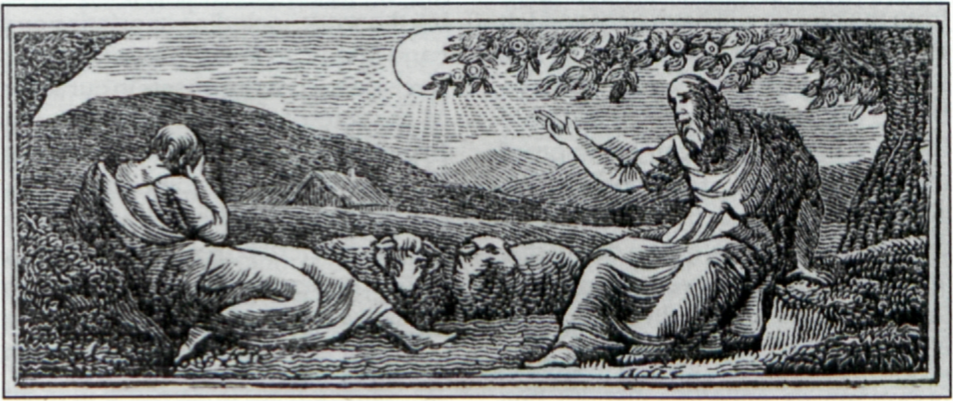
Unlike his precursor, Cromek, Thornton did not immediately turn to another craftsman to execute Blake’s designs. One vignette present in the relief etching was re-cut in reverse on wood by a journeyman (illus. 14), but it follows Blake’s drawing (illus. 13, middle) and wood engraving in the position of the sheep and the presence of the cottage while adding its own unique variants (e.g., the positions of Colinet’s head and Thenot’s arms). This anonymous cut was probably copied after Blake’s own wood engraving, for the journeyman has left out the dog, clearly visible in the drawing but easily overlooked in Blake’s cut. Blake was evidently given a second chance to participate in the project, probably after firm orders that he execute wood engravings begin page 126 | ↑ back to top to match the medium of most of the other illustrations and clothe his characters in a more decorous fashion.
In contrast to relief etchings, wood engravings require reasonably detailed preliminary drawings, either on paper for subsequent transfer to the blocks or drawn directly on them. For the Virgil designs, Blake followed the first alternative, a decision that may have been prompted by the desire—or a request from Thornton—to have the drawings approved before investing all the time and labor required of wood engraving. The drawings are far less challenging to conventional sensibilities than either the relief etching or the wood engravings. One can well imagine a journeyman wood engraver turning these drawings into cuts not very different from others planned for the Virgil volumes, as was indeed the case with the re-cut design reproduced here (illus. 14) and three vignettes published in the book. As Geoffrey Keynes has pointed out, Blake’s “preliminary designs gave no hint of what the final result would be.”14↤ 14 Keynes, introduction to The Illustrations of William Blake for Thornton’s Virgil with the First Eclogue and the Imitation by Ambrose Philips (London: Nonesuch P, 1937) 9, rpt. in Keynes, Blake Studies, 2nd ed. (Oxford: Clarendon P, 1971) 137.
Blake’s next step was to transfer the drawings to the wood. This he probably accomplished by making pencil tracings of the pen and wash drawings and counterproofing or caulking them from the back onto the face of the wood blocks. Both these processes will reverse the images so that impressions from the blocks will have right and left as in the drawings. Except for the first and largest design, given its own block, the vignettes were transferred four to a block, as we can see in proof impressions (illus. 3). If Thornton, his agent or publishers, had approved of the drawings, they were no doubt disappointed, perhaps even angered, by the engravings. Unlike the Virgil relief etching, in which the image is defined by black lines alone, the wood engravings are combinations of white and black lines. Other illustrations in Thornton’s volumes are technically similar, but Blake’s way of handling the medium is highly unconventional. The journeymen wood engravers were following in the tradition of Thomas Bewick, whereas Blake’s integrations of black and white lines grew from his own deployment of white lines in relief etchings and the technique of “Woodcut on Copper” Blake described in his Notebook and used for plates such as “Deaths Door” (illus. 11). Thornton must have found himself even worse off than he began, for Blake had presented him with prints even darker and more primitive than the relief etching. It must have been at this point that he turned to journeymen to re-cut Blake’s designs, but was finally persuaded, according to Gilchrist’s familiar story, by several distinguished artists to use seventeen of Blake’s wood engravings. The vignettes were cut down on their sides so that they would fit the width of the book’s leaves and cut apart so that letterpress text could be placed below each. Either Blake or someone else may have taken these final steps, but in either case the work was very probably done as a requirement of the publishers or printers.15↤ 15 Michael J. Tolley has recently argued that Thornton welcomed Blake’s wood engravings and included them in his book quite willingly; see Tolley, “Thornton’s Blake Edition,” University of Adelaide Library News 10 (1988): 4-11. Following Tolley’s lead, Ted Gott has claimed that Blake trimmed the cuts himself to achieve their “further rusticizing” and make some of the vignettes “tighter and more dramatically charged.” See Gott, “‘Eternity in an Hour’: The Prints of William Blake,” in Martin Butlin and Gott, William Blake in the Collection of the National Gallery of Victoria (Melbourne: National Gallery of Victoria, 1989) 136. These are challenging and interesting views, but I do not find them convincing. As Joseph Viscomi has pointed out to me in correspondence, cutting an end-grain wood block is exacting work requiring a special saw. It is unlikely that a publisher would allow an amateur, such as Blake, to tackle the job since the blocks could be damaged by a single false move.
In spite of apparent impediments, the newly-discovered relief etching can be situated into the production process of the Virgil illustrations in a way that complicates, but does not contradict, the previously known record. This compatibility, combined with the design variants and the medium itself, comprises an excellent case for ascribing the work, including its printing and hand tinting, to Blake. This attribution forces some readjustments in our sense of the role of innovative graphics in Blake’s career. The Grave project had heretofore been considered as Blake’s last attempt to use his relief processes for a commercial project. We now know that Blake persisted in such efforts into the last decade of his life. Sadly, the publisher’s evident reaction was much the same. Fortunately, Blake was given the chance to try his hand at wood engraving. Thanks to the remarkable survival of the relief etching, we can now enjoy four of the Virgil designs in two graphic media in which Blake’s genius excelled.

